
 |
| VOICES WEST: SEX IN THE WEST COWBOY-RELATED DOCUMENTS |
| Sex
in the West Bibliography: Ibson - Mysterious |
[Homepage] [Introduction] [Cowboy Poetry] [Cowboy Songs] [Postcards]
* Indicates from the collection of Alan V. Miller
* Ibson, John. "Masculinity under fire: Life's presentation of camaraderie and homoeroticism before, during, and after the Second World War." p.178-199. In Looking at Life Magazine. Washington, DC; London: Smithsonian Institution Press, 2001.
Illustrated with advertisements from the pages of Life, especially Canon Towel ads; Ibson also mentions the long-term romantic correspondence between Admiral Alfred Mahan and Samuel Ashe.
* Ibson, John. "The lost ritual: American men together in studio portraits." p.8-49. In Picturing men: a century of male relationships in everyday American photography. Washington, DC; London: Smithsonian Institution Press, 2002.
Wonderfully illustrated! See figure 33 (1915 photo postcard),"Pat and Mike" dressed as cowboys.
Ibson writes "I do not see this book as a venture in gay history, but rather in men's history; not a work in the history of sexuality, but in the history of intimacy," p.xiii."Actual cowboys and various other men of the frontier had posed for photographs since the introduction of the daguerrotype. It was only in the 1890s, when the frontier had been declared closed by both the U.S. Census and Frederick Jackson Turner -- at the very time that so many men were working in jobs of which the tasks and garb in no way suggested the frontier -- that a huge number of men wanted to pretend for the photographer to be frontier inhabitants, usually cowboys. As Richard Slotkin has maintained, the 'myth of the Frontier [our oldest and most characteristic myth] has found expression through media as varied as the pamphlet, the dime novel, the nineteenth-century historical romance, the stage melodrama, the Wild West Show, the movie, the modern paperback, and the TV miniseries'. " p.58-59
* Improper Bostonians: lesbian and gay history from the Puritans to playland. Compiled by the History Project [originally known as the Boston Area Lesbian and Gay History Project]; foreword by Barney Frank. Boston, MA: Beacon Press, 1998. 212 p.
See: "The Athens of America: the nineteenth century"; among those mentioned are Walt Whitman, F. Holland Day, Julian Eltinge, and many Boston women such as Sarah Orne Jewett. See also Lillian Faderman.
* Ingram, Gordon Brent. "Returning to the scene of the crime: uses of trial dossiers on consensual male homosexuality for urban research, with examples from twentieth-century British Columbia." GLQ: a journal of lesbian and gay studies. 10(1): 77-110, 2003.
Ingram uses court records from the BC Office of the Attorney General for the years 1909-1967. He notes the limitations of using these resources: the cases are mostly from the cities of Vancouver and Victoria; the majority of the men came from non-European countries; few women lived here until well into the twentieth century; few "first nations" men were involved; and most early cases seem to target South Asians, especially Sikhs.
Irvine, Janice M. Disorders of desire: sex and gender in modern American sexology / Janice M. Irvine. Philadelphia, PA: Temple University Press, 1990. 345 p.
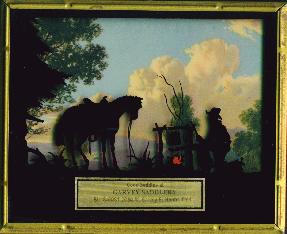 |
Garvey
Saddlery, El Morte, Calif. 195- |
Jasen, David A.; Jones, Gene. Spreadin' rhythm around: Black popular songwriters, 1880-1930 / David A. Jasen, and Gene Jones. New York: Schirmer, 1998. 435 p.
See also p.112-113 for discussion of Robert Cole and J. Rosamond Johnson's successful 'Indian' show "The red moon," 1908.
* Jeb and Dash: a dairy of a gay life, 1918-1945. Edited by Ina Russell. Boston, MA: Faber and Faber, 1994, c1993. 285 p.
Jeffs, William Patrick. "'Man's words' and manly comradeship: language, politics and homosexuality in Walt Whitman's works." Journal of homosexuality. 23(4): ?, 1992.
Jennings, William Dale. The cowboys / William Dale Jennings. New York: Bantham Books, 1972.
* Joffe, Bruce H. A hint of homosexuality? ‘Gay' and homoerotic imagery in American print advertising / Bruce H. Joffe. [Philadelphia, PA]: Xlibris, 2007. 214 p.
Some of us knew about the WWII campy Cannon towels advertisements, but WWI also had it's own: Ivory Soap ads. This book is filled with wonderful imagery, but sadly not indexed.
Johnson, David K. "The kids of fairytown: gay male culture on Chicago's near north side in the 1930s." p.97-118 In Creating a place for ourselves: lesbian, gay, bisexual community histories. Edited by Brett Beemyn. New York: Routledge, 1997.
* Johnson, Susan Lee. "Bulls, bears, and dancing boys: race, gender, and leisure in the California gold rush." Radical history review. 60: 4-37, 1994.
Such differences in age, strength, and inclination could contribute to a cross-gendering of men's relationships with one another - so much so that the term 'homosocial' itself becomes inadequate to describe those relationships ... Reveler Alfred Doten made an even more tantalizing reference in one of his diary entries, which describes a Sunday fandango with visiting Chileans ... he noted in his diary, 'There is a Chileno hermaphrodite camped near Brooks' store [ca 1849]." p.23
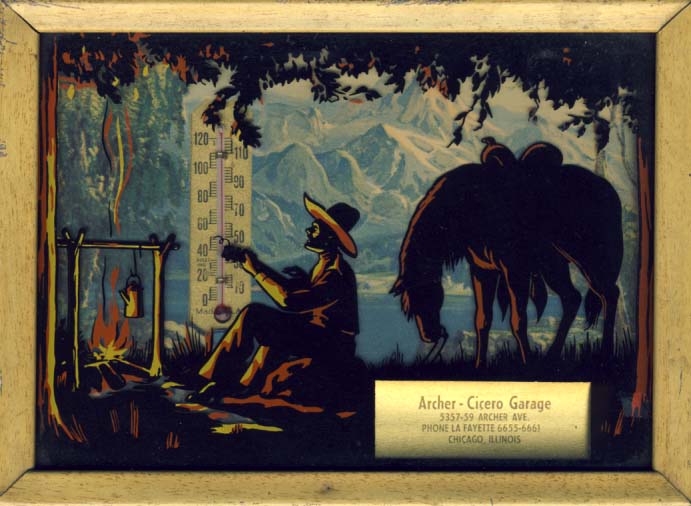 |
Archer-Cicero Garage. 5357-59 Archer Ave., Chicago, Illinois. 195- |
* Johnson, Susan Lee. "Bulls, bears, and dancing boys: race, gender, and leisure in the California gold rush." p.45-71. In Across the great divide: cultures of manhood in the American West. Edited by Matthew Basso, Laura McCall and Dee Garceau. New York: Routledge, 2001. 308 p. Reprinted from the Radical history review, 1994
Johnson, Susan Lee. 'The gold she gathered': difference, domination and California's southern mines, 1848-1853 / Susan Lee Johnson. Ph.D dissertation. Yale University, 1993. See: p.195,266-275 for content.
Johnson, Susan Lee. "A memory sweet to soldiers: the significance of gender." p.255-278. In A new significance: re-envisioning the history of the American West. Edited by Clyde A. Milner, II. New York: Oxford University Press, 1996. 318 p.
* Johnson, Susan Lee. "‘My own private life': toward a history of desire in Gold Rush California." p.316-346. In Rooted in barbarous soil: people, culture and community in Gold Rush California. Edited by Kevin Starr and Richard J. Orsi. Berkeley; Los Angeles CA: University of California Press, published in association with the California Historical Society, 2000. 364 p.
Jones, William E. (Grumble). Letter to Gen. William W. Loring. 1852. Quoted in T.P. Lowry The story the soldiers wouldn't tell. Mechanicsburg, PA: Stackpole Books, 1994. p. 112.
* Jussim, Estelle. Slave to beauty: the eccentric life and controversial career of F. Holland Day, photographer, publisher, aesthete / Estelle Jussim. Boston, MA: D.R. Godine, 1981. 309 p.
On the life and photography of F. Holland Day (1864-1933). Day was the supposed lover of Kahlil Gibran, but his homosexuality may be a major factor in his lack of visibility. See small review by Charles R. Musgrave, Drummer, no.47, 1981, p.101.
* Katz, Jonathan Ned. "Coming to terms: conceptualizing men's erotic and affectional relations with men in the United States, 1820-1892." p.216-235. In A queer world: the Center for Lesbian and Gay Studies reader. Edited by Martin Duberman. New York: New York University Press, 1997.
'Friendship' was another of the prominent terms used by men in the early and mid-nineteenth century for naming and conceptualizing intense, sometimes erotic relationships of men with men." p.217
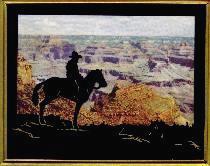 |
Untitled
cowboy silhouette 195- |
* Katz, Jonathan Ned. Gay/lesbian almanac: a new documentary / Jonathan Ned Katz. New York: Harper and Row, 1983.
Contains more information on Lucille Hart/Dr. Alan Hart. See also Bert Hansen
* Katz, Jonathan Ned. "The invention of heterosexuality." Socialist review. 20: 7-34, 1990.
* Katz, Jonathan Ned. The invention of heterosexuality / Jonathan Ned Katz. New York : Dutton, 1995. 291 p.
* Katz, Jonathan Ned. Love stories: sex between men before homosexuality / Jonathan Ned Katz. Chicago, IL: University of Chicago Press, 2001. 426 p.
Included in the book are chapters, mostly on events from the east coast of the United States, dealing with Abraham Lincoln and Joshua Speed; Albert Dodd; Walt Whitman in New York and Camden and his correspondence with John Addington Symonds and Edward Carpenter -- as well as working class men; Peter Sewally (alias Mary Jones); Fred W. Loring and William W. Chamberlin; Charles Warren Stoddard and Francis Davis Millet; John Safford Fiske; "Claude Hartland"; "Earl Lind" also known as Ralph Werther; James Mills Peirce.
Kennedy, Elizabeth L. “But we would never talk about it: the structures of lesbian discretion in South Dakota, 1928-1933.” In Inventing lesbian cultures in America. Edited by Ellen Lewin. Boston, MA: Beacon Press, 1996.
On the life of Julia Boyer Reinstein.
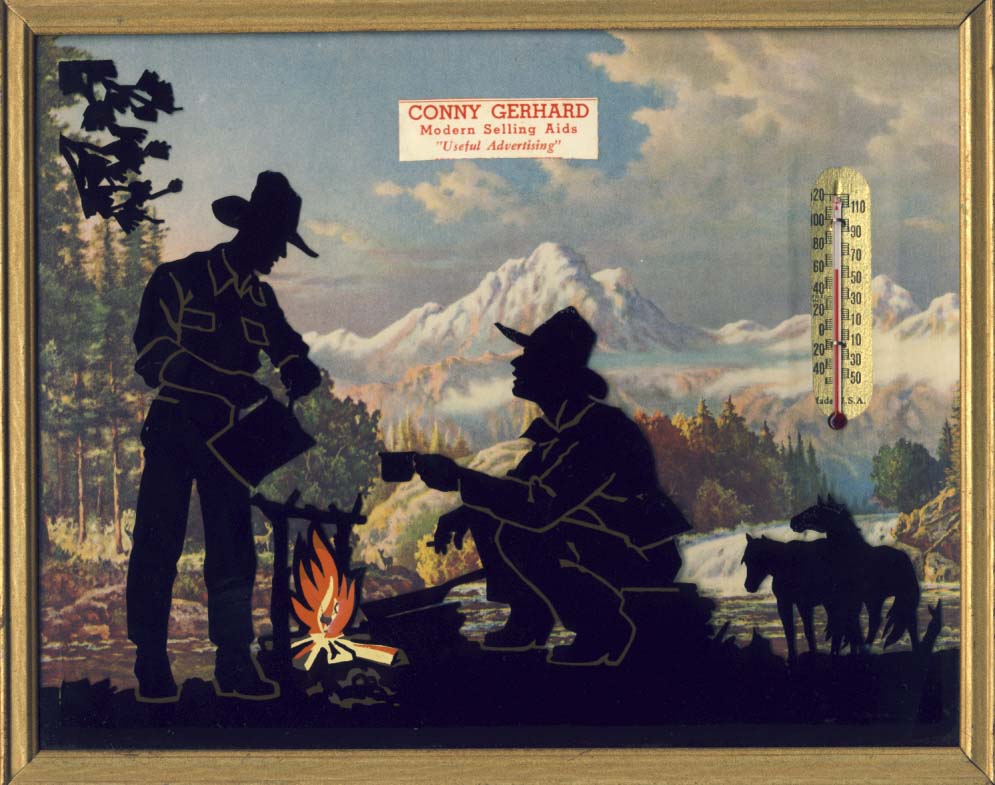 |
Conny Gerhard. Modern Selling Aids. "Useful advertising". 195- |
* Kennedy, Elizabeth Lapovsky. "Telling tales: oral history and the construction of pre-Stonewall lesbian history." p.181-198. In Queer world: The Center for Lesbian and Gay Studies reader. Edited by Martin Duberman. New York: New York University Press, 1997. 705 p.
The author considers how storytelling styles reveal information about cultural and class differences among lesbians, how the subjective adds meaning to lesbian identity, she then discusses the cultural uses of memory in interpreting the gay and lesbian past, and also examines the constructed nature of oral history for pre-1969 America. See Julia Reinstein, who lived as a lesbian from 1928 to 1942 in South Dakota. p.185
* Kennedy, Elizabeth Lapovsky; Davis, Madeline D. Boots of leather, slippers of gold: the history of a lesbian community / Elizabeth Lapovsky Kennedy and Madeline D. Davis. New York: Routledge, 1993. 434 p.
A study of Buffalo, New York, lesbian history, looking into the "pre-political" consciousness of working class lesbians mostly in the post-World War II period (1930s-1950s).
Kimmel, Michael. "It's a boy's life." Village voice literary supplement, April 1985.
Review of David MacLeod Building character in the America boy: the Boy Scouts, YMCA and their forerunners, 1890-1920.
* Kimmel, Michael. Manhood in America: a cultural history / Michael Kimmel. New York; Toronto: The Free Press, 1996.
 |
Williamsfield Farmers Co-operative Ass'n., Inc. Williamsfield, Ill. 1951 |
Kinsey, Alfred; Pomeroy, Wardell, B.; Martin, Clyde E. Sexual behavior in the human male / Alfred Kinsey, Wardell B. Pomeroy, and Clyde E. Martin. Philadelphia, PA: Saunders, 1948.
* Kinsey, Joni L. “Cultivating Iowa: an introduction to Grant Wood.” p.11-33. In Grant Wood's studio, birthplace of American Gothic. Edited by Jane C. Milosch. New York: Prestel, with Cedar Rapids Museum of Art, 2005. 143 p
"Homosexuality, of course, was the one accusation in 1940 that could have ruined Wood's reputation merely by implication. Its virtual absence from the university [University of Iowa] documents, even though it was obviously an element in the controversy, is an indication of its delicacy at the time. Beyond these brief references there is no mention of the issue (although it has been a subject of considerable speculation in more recent years), even though the discussion about Wood and the problems in the art department lasted for months and was otherwise carefully documented." p.29
Klawans, Stuart. "Come on down to the raft again, Huck, honey." Nation. December 13, 1993, p.744. (See also Leslie A. Fiedler.)
Koestenbaum, Wayne. Double talk: the erotics of male literary collaboration / Wayne Koestenbaum. New York: Routledge, 1989. 214 p.
Much on Freud and John A. Symonds.
* Kollin, Susan. "Wister and the ‘New West'" p.233-254. In Reading The Virginian in the New West. Edited by Melody Graulich and Stephen Tatum. Lincoln: University of Nebraska Press, 2003.
"Recently, critics [including Blake Allmendinger] have begun reexaming the relationship between the protagonist and other male characters in the novel in order to draw attention to the queer subtext of The Virginian. Scholars have, for instance, focused on the cowboy hero's friendship with Steve, the only figure in the novel who calls him by nickname ('Jeff'), and his relationship with the tenderfoot narrator, who frequently adopts a feminized position in the text ... Throughout the text, the narrator frequently expresses despair at his inadequate powers of description and, at times, laments his fate in not having been born 'a woman myself'." p.242-243
* Koskovich, Gerard. "A gay modernist: homosexuality in the life and art of Charles Demuth." Advocate (Los Angeles). June 25, 1985, p.50-52. (See also Gail Scott.)
Charles Demuth (1883-1935) was a significant early American modernist and friend of Marsden Hartley. Demuth's homoerotic work was mostly self-suppressed.
"The patterns of Demuth's biography reflect fairly clearly a struggle to validate his homosexual desires while 'passing as straight' for self-protection. The emergence of a homosexual underground by the end of the 19th Century in cities like New York - with cruising areas, bars, cafes, bathhouses and similar territories virtually unknown to mainstream society - made this possible, but the activity required discretion and ingenuity, for exposure could spell social ruin." p.51.
* Kraft, James. Who is Witter Bynner?: a biography / James Kraft. Albuquerque, NM: University of New Mexico Press, 1995. 125 p.
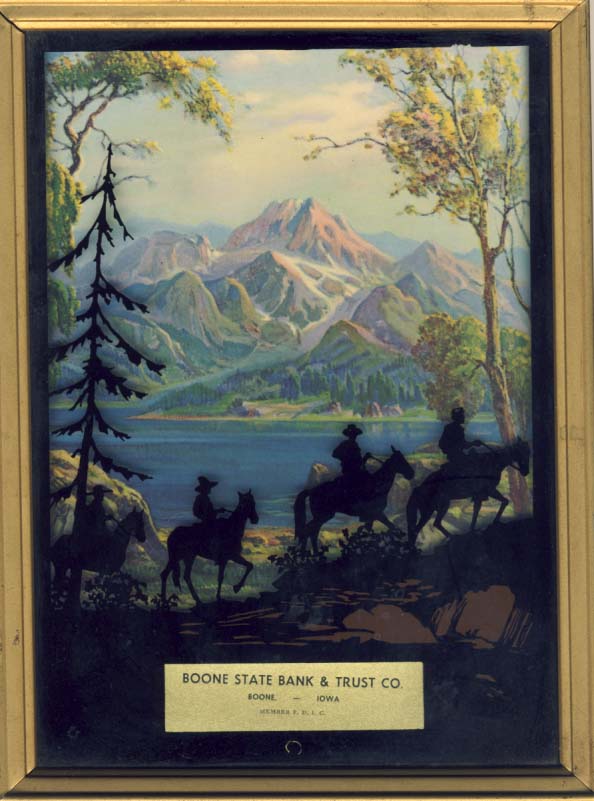 |
Boone State Bank & Trust Co. Boone, Iowa. 195- |
* Lang, Sabine. Men as women, women as men: changing gender in Native American cultures / Sabine Lang. Translated from the German by John L. Vantine. Austin, TX: University of Texas Press, 1998. 398 p. See index for numerous references to the berdache and homosexuality.
Larson, C. Kay. "Bonny Yank and Ginny Reb." Minerva. Spring 1990. Passing women.
Larson, C. Kay. "Bonny Yank and Ginny Reb revisited." Minerva. Summer 1992. Passing women.
Lavender, David. The American heritage of the great west / David Lavender. New York: American Heritage, 1965.
* Leddick, David. Intimate companions: a triography of George Platt Lyons, Paul Cadmus, Lincoln Kirstein, and their circle. New York: St Martin's Press, 2000. 316 p.
Covers the New York City art scene from the 1920s to the 1950s and lives of photographer Lyons, artist Cadmus and Kirstein, who was cofounder of the New York City Ballet.
Lee, Hermione. Willa Cather: double lives / Hermione Lee. New York: Vintage, 1989.
Leonard, Elizabeth D. All the daring of the soldier: women of the Civil War armies. New York: W.W. Norton and Co., 1999. 368 p.
See ch.5 "The beardless boy was a universal favorite" p.165-197. Much on Sarah Emma Edmonds posing as Franklin Thompson.
Leverenz, David. Manhood and the American renaissance / David Leverenz. Ithaca, NY: Cornell University Press, 1989. 372 p.
* Leverich, Lyle. Tom: the unknown Tennessee Williams / Lyle Leverich. New York: WW Norton, 1995. 644 p.
This book covers the early years of the life of Tennessee Williams, growing up in St Louis, his trips to California, Santa Fe and Taos; see his 1939 poem "Cried the fox for D.H.L." p.321.
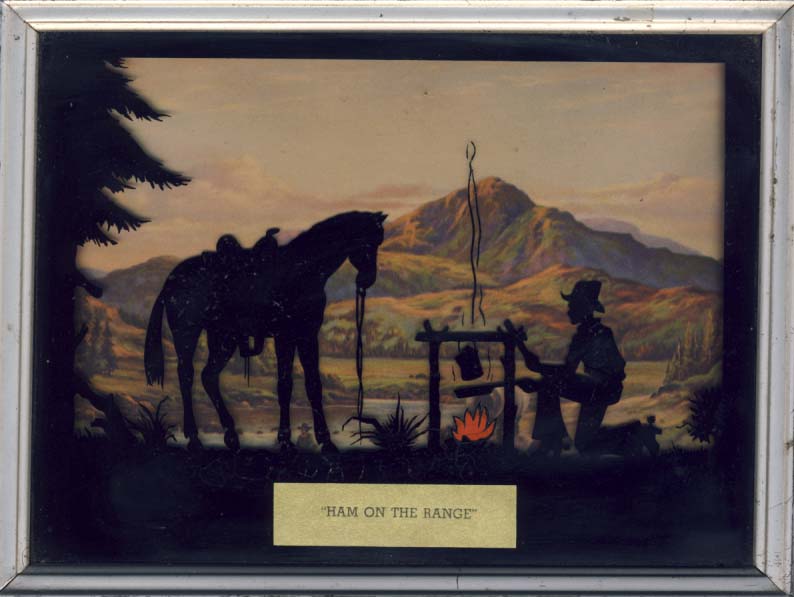 |
"Ham on the range." |
Lewis, Lloyd; Smith, Henry. Oscar Wilde discovers America [1882] / Lloyd Lewis and Henry Smith. New York: Benjamin Blom, 1967, c1936. 462 p.
"The Denver Times had discovered a resident of the city who had gone to school with Oscar Wilde. The Englishmen claimed that he had slept with Oscar in the same dormitory, although not in the same bed. During school days the future Aesthete had not mixed well with his playmates. He had preferred to look a peacocks' feathers and the red labels on tomato cans." p.309 (See also Lewis O. Saum)
Lindemann, Marilee. Willa Cather: queering America / Marilee Lindemann. New York: Columbia University Press, 1999. 185 p.
"In her later years, so the story goes, feeling increasingly despairing about the state of the world and believing herself to be surrounded by enemies (from hostile reviewers to fellow Nebraskans who pretended to be friends), Cather sought to protect her reputation by destroying as many letters as she could lay her hands on, urging friends to destroy those she could not, and finally stipulating in her will, executed in 1943, that direct quotation from and republication of surviving letters be forbidden. That stipulation, which is still dutifully enforced by Cather's estate and by the repositories that hold and control access to the letters, has hampered Cather scholarship immeasurably, though it has by no means succeeded in keeping the author's 'private' life and letters out of bounds." p.17-18.
See ch.4: "Comrades and countrymen: queer love and a dream of 'America'," p.115-132, where Lindemann deals with Cather's Death comes for the Archbishop (1927).
* Lindquist, Lisa J. "Images of Alice: gender, deviancy and a love murder in Memphis." Journal of the history of sexuality. 6(1): 30-61, July 1995.
Littleton, Taylor D. The color of silver: William Spratling, his life and art / Taylor D. Littleton. Baton Rouge, LA: Louisiana State University Press, 2000. 322 p.
William Spratling lived in New Orleans and in 1929 moved to Taxco, Mexico, and reestablished the silver industry there. Littleton deals mostly with Spratling's industry, avoiding too much discussion of Spratling's sexuality. (See also W. Kenneth Holditch and Joan Mark)
"But perhaps for the Spratling story, the Hart Crane interval [1931] with its embarrassing episode that saw Crane banished from Taxco residency is revealing in that it confronted Spratling with his own homosexual tendencies, which, from what evidence there is, had lain discreetly latent during the New Orleans years and during the early period of his Mexican apprenticeship." p.231
* Lofaro, Michael A. "Riproarious shemales: legendary women in the tall tale world of Davy Crockett almanacs." p.114-152. In Crockett at two hundred: new perspectives on the man and the myth. Edited by Michael A. Lofaro and Joe Cummings. Knoxville, TN: University of Tennessee Press, 1989. 252 p. (See also Carroll Smith-Rosenberg.)
"These shemales then are at least in part the result of the projected comic fantasies of eastern male writers who saw the frontier as an almost equal opportunity experience regardless of the sexual stereotypes of the day, simply because the wilderness is freedom and no rules apply." p.146
Longstreet, Stephen. The wilder shore: a gala social history of San Francisco's sinners and spenders, 1849-1906 / Stephen Longstreet. Garden City, NY: Doubleday, 1968.
"A small huddle of homosexuals ... worked out of a central Turkish bath." p.262-263
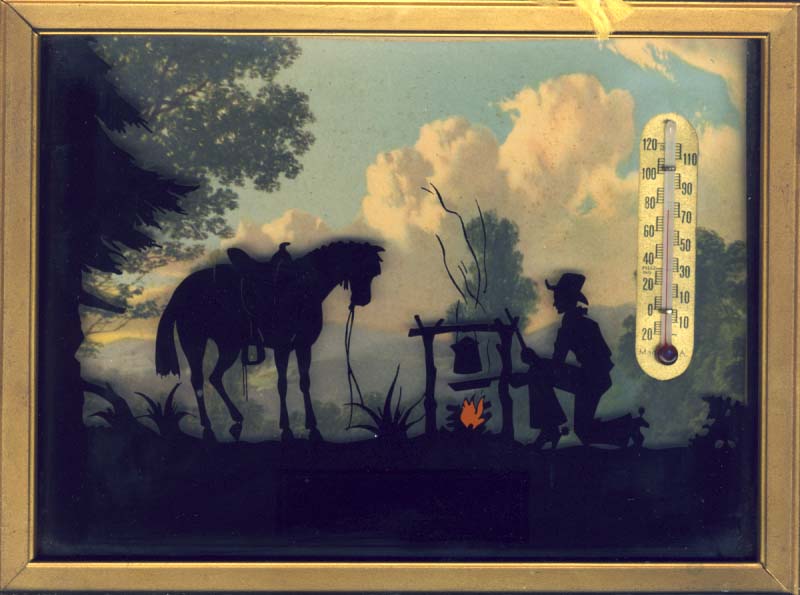 |
Newton Mfg. Co. |
Lott, Eric. Love and theft: Blackface, minstrelsy and the American working class / Eric Lott. New York; Oxford: Oxford University Press, 1993. 314 p.
Loughery, John. Alias S.S. Van Dine / John Loughery. New York: Scribners, 1992.
Loughery, John. The other side of silence: men's lives and gay identities: a twentieth-century history / John Loughery. New York: Henry Holt & Co., 1998. 507 p.
* Lowry, Thomas P. The story the soldiers wouldn't tell: sex in the Civil War / Thomas P. Lowry. Mechanicsburg, PA: Stockpole Books, 1994. 209 p.
* Ludington, Townsend. Marsden Hartley; the biography of an American artist / Townsend Ludington. Boston, MA; Toronto, ON: Little, Brown and Co., 1992. 325 p.
See ch.2: "The need of comrades," p. 29-39. "Hartley's passion for the 'Master,' the church, and his particular church's male congregation [1900, New York City] was his way of channeling his sexual attraction for his friends ... His loneliness, his peripatetic nature, his ideas, and the subjects of his paintings all stemmed in part from his homosexuality." p.29
"If Hartley found satisfaction in the countryside, he was soon disappointed with the people whom he met in Taos, excepting the Sternes, Mrs. Converse, Loe Stein, and a few others. The rest were 'simply impossible, dreadful painters, who are just nasty tongued.' ... The other artists, no doubt, were put off by Hartley's affectations, his penchant for solitude, and the arrogance he displayed about both his painting and his writing. Then, too, most of the other male artists liked to display their manliness. There was a macho quality about them, and this set Hartley off. So he avoided that company, kept to himself, and occasionally took trips into the countryside." p.143. Hartley also published some poetry in El Palacio (Santa Fe) when he visited in December 1918.
* Lugowski, David M. "Queering the (new) deal: lesbian and gay representation and the Depression-era cultural politics of Hollywood's Production Code." Cinema journal. 38(2): 3-25, Winter 1999.
"The men in ten-gallon hats and fringed chaps whom cowpoke Joe E. Brown is delighted to find in New York in 'The Tenderfoot' (1932) turn around to reveal themselves as lipsticked and rouged chorus boys who acknowledge him with a flirtatious 'Whoo!"" p.6
Lydston, G. Frank. "A phase of sexual perversion as illustrated by the recent tragedies." Saint Louis medical mirror 3: 118, Mar. 1892.
"A layman has done more to bring the subject of sexual perversion, as illustrated in the Mitchell-Ward case [Memphis], before the public than has any scientific physician." (Lisa Duggan, 2000, p.181)
* Lynch, Michael. "Here is adhesiveness: from friendship to homosexuality." Victorian studies. 29: 67-96, Autumn 1985.
Michael Lynch deals with Walt Whitman and phrenology.
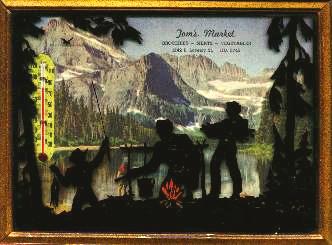 |
Tom's
Market, n.p. 195- |
Lystra, Karen. Searching the heart: women, men, and romantic love in nineteenth-century America / Karen Lystra. New York: Oxford University Press, 1989.
* MacLane, Mary. The story of Mary MacLane, by herself / Mary MacLane. London: Grant Richards, 1902. 322 p. (also Chicago, IL: Herbert S. Stone and Co., 1902.)
MacLane (1881-1929) was born in Canada and settled in Butte, Montana. (See also I, Mary MacLane. New York: Stokes, 1917.)
"Are there many things in this cool-hearted world so utterly exquisite as the pure love of one woman for another woman? My one friend is a woman some twelve or thirteen years older than I ... but I love Fannie Corbin with a peculiar and vivid intensity, and with all the sincerity and passion that is in me." p.38-39
"My love for her is a peculiar thing. It is not the ordinary woman-love. It is something that burns with a vivid fire of its own." p.179
"I feel in the anemone lady [Corbin] a strange attraction of sex. There is in me a masculine element that, when I am thinking of her, arises and overshadows all the others." p.182
Macleod, David L. Building character in the American Boy: the Boy Scouts, the YMCA and their forerunners, 1870-1920 / David L. Macleod. Madison, WI: University of Wisconsin Press, 1983. 404 p. (See also Michael Kimmel.)
* Mann, William J. Behind the screen: how gays and lesbians shaped Hollywood. New York: Penguin Group, 2001. 422 p.
Early Western film and Canadian content; see David Manners (University of Toronto graduate), Dorothy Arzner (Covered Wagon, 1923), Francis O'Brien, William Haines (Way Out West, 1930), J. Warren "Jacky" Kerrigan.
Mariani, Paul. The broken tower: a life of Hart Crane / Paul Mariani. New York: WW Norton, 1999. 492 p.
See ch.15: "Viva Mexico! Mexico, September 1931- January 1932," and ch.16: "The broken tower, Mexico February -April 1932," p.381-421. American poet Hart Crane (1899-1932) committed suicide while returning to New York after a year in Mexico. There he met with Marsden Hartley, Witter Bynner and William Spratling. Crane's tormented life and alcoholism are dealt with in this section.
See also biography by Clive Fisher.
* Mark, Joan. The silver gringo: William Spratling and Taxco / Joan Mark. Albuquerque, NM: University of New Mexico Press, 2000. 154 p.
See also W. Kenneth Holditch, Taylor D. Littleton and William Spratling and the Mexican silver renaissance
William Spratling (1900-1967) lived in New Orleans, moved to New York in 1928 to live with William Faulkner on Christopher Street, and in 1929 moved to Taxco, Mexico, and reestablished the silver industry there. People he befriended included Hart Crane, Marsden Hartley, Witter Bynner, and Diego Rivera.
"One story told in Taxco is that Spratling came to Mexico to recover from a nervous breakdown. The comment 'Bill is well again' may refer to this. Another persistent rumor in Mexico holds that it was a homosexual incident. possibility one involving a student, that caused Spratling's departure from Tulane." p.15-16
"In the summer of 1931 a twenty-four-year-old art student and puppeteer from Minneapolis, Donald Cordry, turned up in Taxco. Cordry was 'a tall young man of singular physical beauty' and a romantic who liked to say that he lived 'only for beauty.' He and Spratling became very good friends, lovers, according to local gossip." p.31
"With good friends, Spratling was very open about his activities at the [Turkish] baths in Mexico City, his attitude being that they ought to try it, that it was just another activity he pioneered, that he enjoyed it enormously and they would too if they would lose their inhibitions." p.115
Marsh, Margaret. "Suburban men and masculine domesticity, 1870- 1915." American quarterly. 40: 165-186, June 1988.
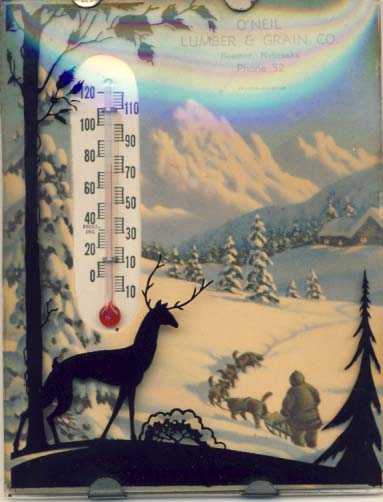 |
O'Neil Lumber & Grain Co. Beemer, Nebraska. [Erickson, Des Moines.] 193- |
Martin, Robert K. "Bayard Taylor's valley of bliss: the pastoral and the search for form." Markham review. 9:13- 17, Fall 1978.
On Bayard Taylor's California poems.
* Martin, Robert K. The homosexual tradition in American poetry / Robert K. Martin. Austin, TX: University of Texas Press, 1979.
* Martin, Robert K. "Knight errant and gothic seducers: representations of male friendship in nineteenth-century America." In Hidden from history: reclaiming the gay and lesbian past. Edited by Martin Duberman, Martha Vicinus and George Chauncey. New York: New American Library, 1989.
* Martinac, Paula. The queerest places: a national guide to gay and lesbian historic sites / Paula Martinac. New York: Owl Book (Henry Holt), 1997. 350 p.
* Mather, R.E. (Ruth E.); Boswell, F.E. John David Borthwick: artist of the gold rush / R.E (Ruth E.) Mather and F.E. Boswell. Salt Lake City, UT: University of Utah Press, 1989, c1988. 216 p.
"He captured a scene of the miners [in Angel's Camp, California, 1852] performing 'Lady's Chain,' but ironically enough without any ladies. The lack was remedied 'by a simple arrangement whereby it was understood that every gentleman who had a patch on a certain part of his inexpressibles should be considered a lady for the time being. These patches were rather fashionable, and were usually large squares of canvas, showing brightly on a dark ground.' What J.D. portrayed in the drawing was how the miners danced 'as they did everything else, with all their might.'" p.122
The quote is from John David Borthwick's Three years in California. Edinburgh: Blackwood and Sons, 1857. p.320-321
* Maynard, Steven. "'Horrible temptations': sex, men, and working-class male youth in urban Ontario, 1890-1935." Canadian historical review. 78: 191-235, June 1997.
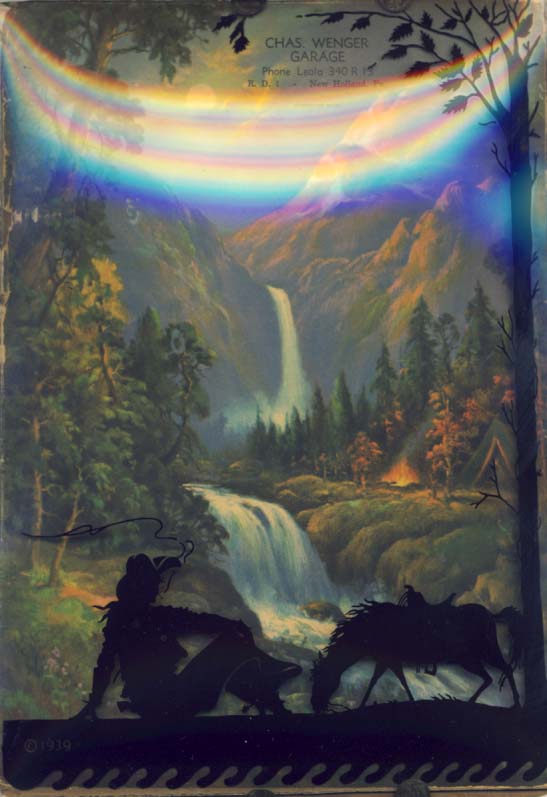 |
Chas. Wenger Garage. New Holland, Pa. [Erickson, Des Moines.] 1939 |
That Ontario courts sent men charged with homosexual offences for psychiatric examination beginning around 1910 - the earliest examination I discovered dates from 1905 - suggests that the Canadian state, at least at the local level, began to draw on the power of medical professionals and medical discourse sooner than in the United States." p.67
* Maynard, Steven. "Through a hole in the lavatory wall: homosexual subcultures, police surveillance, and the dialectics of discovery, Toronto, 1890-1930." p.165-184. Gender and History in Canada. Edited by Joy Parr and Mark Rosenfeld. Toronto : Copp Clark Ltd., 1996. (Abridged from the Journal of the History of Sexuality, 1994)
Mayne, Xavier [Edward Irenaeus Prime-Stevenson, 1868-1942]. Imre: a memorandum / Edward Prime-Stevenson. Reprint. New York: Arno Press, 1975, c1906.
See also James Gifford and Philip Miller
Mayne, Xavier [Edward Prime-Stevenson]. The intersexes: a history of similisexualism as a problem in social life / Edward Prime-Stevenson. Reprint. New York: Arno Press, 1975, c1908.
McCluskey, Sally. "Black Elk speaks, and so does John Neihardt." Western American literature. 6: 231-242, Winter 1972.
McCluskey, Sally. Image and idea in the poetry of John G. Neihardt / Sally McCluskey. Ph.D. dissertation. Northern Illinois University, 1974.
* McGarry, Molly; Wasserman, Fred. Becoming visible: an illustrated history of lesbian and gay life in twentieth-century America. Based on an exhibition curated by Fred Wasserman, Molly McGarry and Mimi Bowling. New York: New York Public Library; Penguin Studio, 1998. 282 p.
Based on the 1994 New York Public Library show, "Becoming visible," which celebrated the 25th anniversary of the Stone Wall riots of 1969. See especially the sections "Sodomites, perverts and queers," and "Social worlds." Beautifully illustrated throughout.
* McIntosh, Mary. "The homosexual role." Social problems. 16: 182-192, 1968.
* McLellan, Diana. The girls: Sappho goes to Hollywood. New York: LA Weekly Book, for St. Martin's Press, 2000. 440 p.
Lesbians in the early years of film production; information mostly from previously published sources and interviews.
Meanings for manhood: constructions of masculinity in Victorian America. Edited by Mark C. Carnes and Clyde Griffen. Chicago, IL: University of Chicago Press, 1990. 281 p.
* Meyerowitz, Joanne. "Sexual geography and gender economy: the furnished-room districts of Chicago, 1890-1930." p.43-71. In Gender and American history since 1890. Edited by Barbara Melosh. London: Routledge, 1993.
* Meyerowitz, Joanne. Women adrift: independent wage earners in Chicago, 1880-1930 / Joanne Meyerowitz. Chicago, IL: University of Chicago Press, 1988. 281 p.
Middleton, Lee. Hearts on fire / Lee Middleton. Coolville, OH: Alberta Taylor Civil War Books, 1993.
* Miller, Neil. Out of the past: gay and lesbian history from 1869 to the present / Neil Miller. New York: Vantage Books, 1995. 657 p.
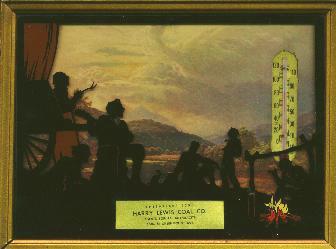 |
Harry
Lewis Coal, Pa. 195- |
Miner, Madonne. "Documenting the demise of manly love: Owen Wister's 'Virginian'." Journal of men's studies. 1(1), ?, 1992.
Miner, Madonne. "Manhood on the make: Owen Wister's 'Virginian'." Men's studies review. 8(4): 155, 1991.
Minton, Henry. Departing from deviance: a history of homosexual rights and emancipatory science in America / Henry Minton. Chicago, IL: University of Chicago Press, 2002. 344 p.
Minton reveals, in part , an early history of research production and collaboration on the part of American gay and lesbian activists-researchers in the 1930s. Several worked with the George W. Henry and the Committee for the Study of Sex Variants, and they included Jan Gay (1902-1960), Alfred A. Gross (1895-1987), and Thomas Painter (1905-1978).
Mitchell, Lee Clark. Westerns: making the man in fiction and film / Lee Clark Mitchell. Chicago, IL: University of Chicago Press, 1996.
"Otherwise, not only is the Western a genre that allows us to gaze at men, this gaze forms such an essential aspect of the genre that it seems covertly about just that: looking at men. To state the issue so starkly already suggests how problematic that process has always been, and it is no surprise that the hesitations, distortions, and evasions that accompany this male- centered 'look' are customarily interpreted as a deep-seated nervousness over homoeroticism." p.159
* Mitchell, Pablo. "Accomplished ladies and coyotes: marriage, power, and the straying from the flock in Territorial New Mexico, 1880-1920." p.331-351. In Sex, love, race: crossing boundaries in North American history. Edited by Martha Hodes. New York: New York University Press, 1999. 542 p.
* Monaghan, Peter. "At 100, the Western still spurs scholars: books and conferences take new look at the most prominent genre in American culture." Chronicle of higher education. 99(16): A12-A14. (See also Madonne Miner.)
To celebrate the 100th anniversary of the publication of Owen Wister's The Virginian, several books are about to be released. One, Reading 'The Virginian' in the new West (2003), will include an essay on the "queer frontier." The American West(s) in Film, Television and History conference, November 2002, Kansas City, MO, is also noted.
Monroe, George J. "Sodomy-pederasty." Saint Louis medical era. 9: 431, 1899-1900.
* Monroe, Harriet. "What of Mr. [John G.] Neihardt?" Poetry. 30(1): 99-104, May 1927. Important early appraisal.
* Moon, Michael. "Whose history? The case of Oklahoma." In A queer world: the Center for Lesbian and Gay Studies reader. Edited by Martin Duberman. New York: New York University Press, 1997. p.24-34
* Moore, F. Michael. Drag! Male and female impersonators on stage, screen and television / F. Michael Moore. Jefferson, NC: McFarland & Co., 1994.
"Francis Leon played Miss Patient Wilde [a reference to Oscar Wilde's trip to America, in 1882], a young lady partial to sunflowers, in 1881-82 ... Leon established himself as the finest female impersonator in minstrelsy." p.59
Moore, Jacqueline M. Cow boys and cattle men: class and masculinities on the Texas frontier, 1865-1900. New York: New York University Press, 2010. 269 p.
"To modern sensibilities, some of these friendships appear to have been more than just platonic. Cummins and Oden's relationship seemed much like a marriage at times: 'Henry and I for six years did most of the ranch work. Henry being the old man and I the old woman, he doing the milking, horse rustling, etc., while I would do most of the cooking, churning, and attending to the chickens, and in the six years, we never had a cross word.' ... But we must be sure to understand the context in which these events occurred, rather than just judging them by twenty-first century standards or assuming that the men must have been hiding something. In a post-Freud age in which we are aware that many seemingly innocent objects have sexual meanings to our subconscious, and in an environment where the majority of men have defined their masculinity as purely heterosexual, we often read subtexts into nineteenth-century sources that may or may not be there." p.120-121
Morgan, David. "Masculinity, autobiography and history." Gender and history. 2: 34-39, Spring 1990.
Mosse, George. Fallen soldiers: reshaping the memory of world wars / George Mosse. New York: Oxford University Press, 1990. See: p.48,165-166.
* Mrozek, Donald J. "The habit of victory: the American military and the cult of manliness." ch.11, p.220-239. In Manliness and morality: middle-class masculinity in Britain and America, 1800- 1940. Edited by J.A. Mangan and James Walvin. Manchester: Manchester University Press, 1987. 278 p.
See section on General Leonard Wood, Harvard graduate and close friend of Teddy Roosevelt. Wood served with Nelson A. Miles during the campaign against the Apache. "Wood's watchword coupled the Victorian mix of inspiration and practicality with a measure of the male bonding which demanded total reliability from one's 'buddies'. ('We want to stand with our feet squarely on the earth,' he remarked bravely, 'our eyes on God, our ideals high, but steady.') Pronouncing judgment on Wood's life, Teddy Roosevelt succinctly gave voice to the heroic archetype: 'He combined in a very high degree the qualities of entire manliness with entire uprightness and cleanliness of character." p.229
* Mumford, Kevin J. "'Lost manhood' found: male sexual impotence and Victorian culture in the United States." Journal of the history of sexuality. 3(1): 33-57, July 1992.
"Before about 1910, authorities on impotence avoided the issue of sex perversion; when they did discuss the relationship between impotence and homosexuality, their analyses were confused. [George] Beard argued [in 1883] that cases of perversion were 'very much more frequent than supposed' which he had learned from observing homosexuals in New York City." p.53
Murphy, Lawrence R. "Cleaning up Newport: The US Navy's persecution of homosexuals after World War I." Journal of American culture. 7(3): ?, Fall 1984.
Murphy, Lawrence R. "The enemy among us: venereal disease among Union soldiers in the far West." Civil War history. 31(3): ?, 1985.
* Murphy, Lawrence R. Perverts by official order : the campaign against homosexuals by the United States Navy / Lawrence R. Murphy. New York : Haworth Press, c1988. 340 p.
See review by Benjamin Brenkert
* Murphy, Mary. "Making men in the west: the coming of age of Miles Cavanaugh and Martin Frank Dunham." p.133-147. In Over the edge: remapping the American West. Edited by Valerie J. Matsumoto and Blake Allmendinger. Berkeley, CA: University of California Press, 1999. 399 p.
* Myers, John. Pirate, Pawnee and mountain man: the saga of Hugh Glass / John Myers. Boston, MA; Toronto, ON: Little, Brown and Co., 1963. 237 p.
"There [Fort Henry] everything went as wrong for Mike [Fink] as it possibly could. His pride and joy for years had been his adopted son, a young tough known to history on as Carpenter. Devoted to Mike elsewhere, he soured on him while on the Yellowstone and gave the the aging hellion the latter's first trouncing ... Fink himself got drilled [killed] in the course of trying to convince a man called Talbot that he hadn't killed the thing he loved on purpose." p.69
"Whether either of the two had been close to Glass, or had struck up a partnership between themselves, are questions with one doubtful answer. In his 'Song of Hugh Glass' [1915] John Neihardt wrote that Jim - whom he calls 'Jamie' and doesn't supply with a last name - volunteered [to stay with a dying Glass] because he was a protege of Hugh, who had undertaken to school the youngster in wilderness lore." p.126-127
"The mysterious father of American homophile literature." One Institute quarterly. 3: 94-98, Fall 1958. On Xavier Mayne (1868-1942), born Edward Prime Stevenson, who in 1908 authored The intersexes.
[Sex in the West Introduction] [Contents] [Previous page] [Next page]
 |
"Whereof the shining goal was comradeship." |
| Contact owner: Alan V. Miller at millera@cowboysong.com | |
| Last revised: April 25, 2012 |